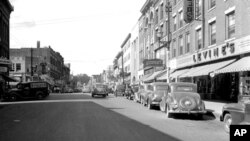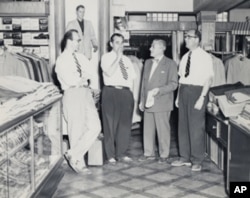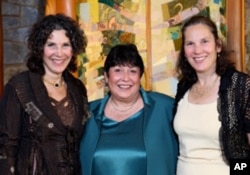For centuries, immigrants have come to America in search of a better life. That's the path William Levine took in the late 1800s, hoping for greater opportunity than what was available to a poor Jew in eastern Europe.
He found success in a small town in the northeastern state of Maine and now Levine's experience is part of a project to document the history of Jewish life in small-town America.
Gathering place
Levine began his new life in the town of Waterville as a peddler, selling fabric and clothing from a cart. Within a decade, he’d opened a store.
Specializing in clothing for men and boys, Levine’s attracted a wide variety of customers, from students at nearby Colby College, to farmers who traveled from miles away to buy a well-made sports jacket.
Levine's great-grandaughter remembers the store, which her father ran for many years with his uncles, as a major social hub in town.
"My uncles were extremely sociable first of all, and they were genuine characters, so people literally came in to say hi to them," says Sara Arnon, who now lives outside of New York. "It was a busy, fun place - especially if you were one of three daughters. It was really a great place to find dates."
Lasting legacy
Arnon's father, Howard Miller, closed the family-run store in 1997 because it was losing business to shopping malls in the suburbs. But its legacy survives as part of the Maine Jewish History Project, which documents Jewish life in small-town America.
"The Levines were a recognizable name and they also kept all of their stuff. You can't do history without records," says David Freidenreich, a professor of religious studies at Colby College who launched the project two years ago.
According to Freidenreich, most books about Jewish life in the United States focus on the greater New York-area experience since most U.S. Jews lived in urban areas.
"I wanted to find some way to teach students about what American Jewish history was like in Maine," he says. "Nobody knew the answers."
Part of the record
Arnon says her great-grandfather helped bring family members to America.
"When he came here he was very instrumental in bringing over his many siblings and other relatives from Russia, Poland."
She remembers there being at least 50 Jewish families in town. Like other immigrant groups, Maine’s scattered Jewish communities managed to connect.
Wendy Miller, another Levine great-grandaughter who is Arnon's sister, says some of the most memorable items the family shared with Colby’s History Project were letters written by young Jews in the early 1900s.
"There were letters from young Jewish girls in the southern part of Maine who had heard of one of the Levine boys," says Miller, "and they would write these introduction letters, 'I don't mean to be forward, but I’ve heard this...' and they're fascinating."
Miller and Arnon's younger sister, Julie Miller-Soros, recalls tight friendships between long-time Mainers and newer arrivals.
"I had Jewish friends because of Hebrew school and Sunday school, but I had my friends that were Protestant, my friends that were Lebanese, my friends who were Christian," Miller-Soros says. "And I didn't know the difference."
Challenging times
It was a different story along the coast of Maine, where high-end resorts banned blacks and Jews through the 1950s.
Miller-Soros says, even by the early 1970s, she couldn't get hired as a waitress in the resort town of Bar Harbor. Her mother had warned her that would happen.
"I thought she was nuts at the time, but I went with my friends and the three of them did get jobs and I did not," Miller-Soros remembers. "They were blonde and blue-eyed."
While sharing their family's history might help scholars and the public develop a fuller picture of Jewish life in rural America, Arnon believes the Levine story is really a universal American story about all immigrants.
"They came from somewhere, for some reason, and for many of us, it was because of persecution somewhere," she says. "So they came to America to find freedom. And I think that, today, we take that for granted."











